Content [show]
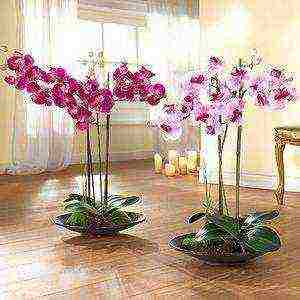 Watching television programs about tropical flora, we are always amazed at the riot of colors and forms of plants growing in those latitudes. Did you know that there are many plants from tropical latitudes that can be quite successfully kept at home, and they will delight you no less than those on the TV screen? In order to prove this, take, for example, an orchid, a flower - which is striking in its originality and at the same time, ease of cultivation.
Watching television programs about tropical flora, we are always amazed at the riot of colors and forms of plants growing in those latitudes. Did you know that there are many plants from tropical latitudes that can be quite successfully kept at home, and they will delight you no less than those on the TV screen? In order to prove this, take, for example, an orchid, a flower - which is striking in its originality and at the same time, ease of cultivation.
How to grow an orchid at home
Although they are considered capricious plants, many flower lovers, both professionals and amateurs, they grow on windowsills without any difficulty. To successfully grow orchids at home, you need to prepare well from the beginning, and then everything will go “knurled” and will be simple and easy. It is necessary to prepare several things: soil, containers for a flower, fertilizer. All this is in abundance in most flower shops. You also need to study information about watering, lighting, transplanting. It is not necessary to delve into the details, but it is necessary to study the general information.
What should be the lighting
What always attracts us in any color is, of course, the bloom itself. So how to grow an orchid at home, and even so that it blooms? This requires a lot of light. Moreover, lighting has a major role here. The most important thing is to find a middle ground, because if there is too much light, the flower will just burn, and with a lack of light, the plant will not bloom at all. The question immediately arises, how to determine this golden mean. Here the flower itself will tell you. With a lack of light, the leaves will be dark green (should be light), and if you overdo it with lighting, the leaves will begin to turn yellow.
Features of watering a plant
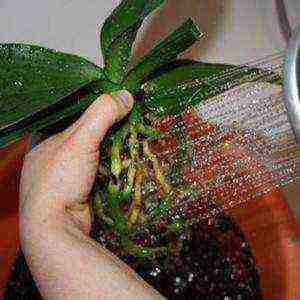 Along with lighting, watering is also important. In nature, orchids never grow in water, their roots cannot tolerate an excess of moisture and standing water, so extreme care must be taken with watering. Factors affect the frequency of watering:
Along with lighting, watering is also important. In nature, orchids never grow in water, their roots cannot tolerate an excess of moisture and standing water, so extreme care must be taken with watering. Factors affect the frequency of watering:
- the duration of daylight hours;
- the size of the container in which the plant is located;
- watering and feeding;
- other external factors such as dry air and ambient temperature.
The plant will immediately react to a lack of moisture with dark green leaves, and to waterlogging yellow leaves and rotten roots.
Increased watering is required only during rapid growth or flowering. Watering should be done as follows. It is necessary to water the plant under the shower with warm water so that the soil is completely wet and the water completely drains out through the drainage holes. Only after the water has completely drained can the plant be put back into the pots.
Selection of soil and capacity
The choice of a pot is very important for the favorable growth of the flower. Mainly used:
- transparent plastic containers;
- clay pots;
- baskets.
Some types of orchids from the epiphytic family are planted on a block. The block can be a piece of bark, and in order to prevent the roots from drying out, moss is used to retain moisture. Mostly miniature species or seedlings are planted on the block.
Now let's look at the soil. The selection of the substrate depends on what kind of variety you want to grow. If it is an orchid from the epiphyte family, then the soil will mainly play the role of supporting the plant in an upright position, protect the roots from excess moisture and provide them with the required amount of air. The substrate should consist of pieces of tree bark, coal, cork, moss, clay in granules and absolutely no garden soil, in general, from those components that do not retain moisture. It is also possible addition of coarse sand.
Any container capable of holding the substrate of the required composition is suitable as a flower pot. To grow terrestrial species, we need a substrate of the same composition as for epiphytes, but with the addition of a small amount of garden soil and dried leaves. All components must be finely ground. It is best to use plastic transparent containers with drainage as a pot. To hide the untidiness of the containers, you can always place the flower in a decorative planter. It is both beautiful and practical.
For beginners, it is advisable to buy ready-made soil in stores, rather than prepare it yourself. Sometimes they even write on the packages for what kind of this or that substrate. After gaining some experience, you can try to prepare soil for terrestrial orchids yourself from a soil mixture for epiphytes, moss and garden soil.
Optimum temperature for the plant
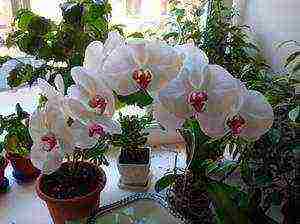 Most plants require daytime temperatures from +18 to +27 degrees, and at night from +13 to +24 degrees. One of the most important conditions for flowering is the difference between night and day temperatures. With central heating, transferring a plant accustomed to heat to a cooler area overnight can produce good results. The plant can sprout. Orchids prefer air humidity of 60–80%.
Most plants require daytime temperatures from +18 to +27 degrees, and at night from +13 to +24 degrees. One of the most important conditions for flowering is the difference between night and day temperatures. With central heating, transferring a plant accustomed to heat to a cooler area overnight can produce good results. The plant can sprout. Orchids prefer air humidity of 60–80%.
If these figures are lower, then they can be achieved by placing a pallet with a grate under the pot. Such pallets can be purchased either in garden stores, or you can make it yourself by pouring water onto the bottom and placing a large layer of gravel on top. The main thing is to make sure that the roots do not touch the water.
In dry weather, spraying with a spray bottle will be helpful. Only it is worth calculating the time so that the plant has time to dry out by night. Plants are very air movement is also important... Especially for cold-loving species. An electric fan can be used for this. But it is worth protecting the plant from strong drafts. While blowing the plant, it is worth increasing the frequency of watering the flower.
Fertilizer selection
 For abundant flowering, regular, balanced feeding is necessary. It is best to do it once every two weeks. It is best to use specialized fertilizers for orchids, which can always be purchased at flower shops.The rules for preparing top dressing are usually written on the package.
For abundant flowering, regular, balanced feeding is necessary. It is best to do it once every two weeks. It is best to use specialized fertilizers for orchids, which can always be purchased at flower shops.The rules for preparing top dressing are usually written on the package.
In no case should you use fertilizers that are intended for other plants. This can lead to illness or even death of the flower. It is also worth remembering that during the rest period one should reduce the frequency of feeding... Sooner or later, the plant will need to be transplanted into a new pot. This is best done after the plant has bloomed and rested a little. The signal for this is the green part of the plant that has grown outside the pot. It is important to remember that you do not need to transplant if the root system just protruded above the surface of the container.
Plant transplant recommendations:
-
 Sometimes, in order to carefully remove the plant from the pot without damaging the root system, you have to cut the pot.
Sometimes, in order to carefully remove the plant from the pot without damaging the root system, you have to cut the pot. - After that, it is necessary to carefully shake off the plant from the old soil, cut off the old dried or decayed roots.
- Then you need to take a container a couple of sizes larger than the old one, pour some new soil on the bottom, put the orchid in a new pot and fill the space between the roots with a suitable substrate.
- After that, lightly press down on the soil, but do not over-compact. It is also necessary to ensure that the top of the flower (growth point) is above the surface of the soil.
Not everyone decides to reproduce orchids at home, since this is associated with a number of difficulties. There are two ways to propagate a flower - this is division during transplantation and seeds... Reproduction by seeds is considered impossible, since in a plant they are the size of pollen and require absolutely sterile conditions for germination, since even the smallest microbes can destroy them. Therefore, if you do not have a mini-laboratory at home, then you should not try. Reproduction by division is also difficult, but still quite real. And if a new plant develops a system of roots and leaves, then in a year it will delight you with flowers and become a wonderful decoration for your home.
Phalaenopsis will become a real decoration for your home. Growing orchids at home is carried out according to specific rules, which will be described in detail in this article.
What type to choose for the house
You can grow a variety of orchids at home. However, it is important to choose the right variety so that you do not have problems with flower care in the future. After all, each type of plant has its own set of requirements for growing conditions. If everything is organized correctly, then caring for orchids in a flowerpot will be simple.
For growing orchids at home, the following varieties are suitable:
- Phalaenopsis. It is Phalaenopsis that is grown more often at home than other types of plants. This flower is distinguished by long flowering, and its flowers can have a wide variety of colors. Growing any phalaenopsis at home will be within the power of even a beginner;
- Dendrobium. Orchids of this species grow in the cool. The flowering period is more than one month;
- Cattleya. Growing conditions for this variety require a warm, but not hot, microclimate. The formation of rather large flowers is characteristic;
- Wanda. It is a heat-loving plant that has a powerful root system. As they develop, the flowers become brighter;
- Zygopetalum. This variety is characterized by the formation of fragrant inflorescences.
There should be no problems with the orchids listed above at home. However, in order to get them to bloom for a long time, you need to know the types of orchids and the secrets of growing each individual variety.
Soil and capacity
To understand how to grow your favorite orchid in a house or apartment, you need to know the specifics of choosing a container and soil for planting a flower.
Growing plants is carried out in a pot, which must meet the following requirements:
- able to support the flower in an upright position;
- provides oxygen and moisture to the roots;
- promotes effective drying of the substrate.
Plastic pots, wire pots and nets have the right characteristics. The Phalaenopsis orchid and its other varieties are most often planted in pots with transparent walls so that the roots can participate in the process of photosynthesis.
In order to grow orchids at home, you need to choose the right substrate. These indoor flowers are planted on a special substrate, in which there is no earth at all. It may include the following components:
- pine bark;
- peat;
- fern;
- charcoal;
- leafy land;
- pine bark;
- sphagnum.
The ratio of the components of the substrate is determined depending on which plant species is planned to be grown in houses or apartments. The substrate can be prepared by hand. But many growers go to specialized stores to buy soil. In the same place, the seller will tell you how to grow 100 or more specimens from one orchid, having bought only one flower. To do this, you just need to know how a particular orchid is grown.
Comfortable conditions
Caring for Phalaenopsis at home involves observing certain parameters of temperature, humidity and illumination. Let's consider in more detail what kind of care and what parameters should be observed when growing these flowers. The secrets of growing orchids will be available to you too.
Lighting and temperature
Phalaenopsis loves partial shade. When placing a flowerpot on a windowsill, avoid direct sunlight. Artificial lighting for orchids is allowed. To do this, you can use special phytolamps, which are designed for additional illumination of indoor plants. This indoor orchid lamp is sold in specialized stores.
Additional illumination should give white light. It is this kind of light that is needed in order for the indoor species to grow and bloom. The backlight is often used in winter, when the daylight hours are the shortest. In the cold season, flowers should be illuminated for at least 12 hours. For this, a phytolamp for indoor orchids is placed above the pot.
In addition to the light regime, a certain temperature is needed for orchids. These indoor plants are better tolerated at elevated temperatures. The optimum temperature for keeping colors is in the range of + 28-30 degrees.
For any gardener who has grown Phalaenopsis at home, it will be useful to know that to stimulate flowering, the plant must be at a temperature of + 12-15 degrees for several weeks.
Watering
An important point in how to grow orchids in an apartment is compliance with the water regime. Watering the flower is carried out only when the substrate dries up. Regarding how to correctly determine the degree of dryness of the substrate, there are several ways (poke into the ground with your finger or stick, etc.). You need to water the plant only with settled warm water.
Humidity
These plants should grow in a humidity range of 60–80%. In order to achieve this level, the plant is periodically sprayed with water and also ventilated. Ventilation is important for cold-hardy species.
How to care for a specific species, you can find out from the seller, who will tell you all the wisdom of its breeding. Experienced growers can also give advice on breeding.
Pests and diseases
For many flower lovers who grew in the conditions of the Phalaenopsis apartment, the flowers were often invaded by parasites or pathogens. Such a situation is possible if planting and care were improperly organized for them (plants).
Plants most often suffer from the following parasites:
- shield. When it appears on the plant, mucus and dark spots are formed;
- worm.When infected, the leaves turn yellow, which then fall off;
- whitefly. The insect feeds on plant sap. As a result, the flower may die.
These indoor flowers most often affect the following ailments:
- anthracnose. The appearance of brown spots is characteristic;
- powdery mildew. A white bloom forms on the flower.
How to grow Phalaenopsis without diseases and pests? You just need to properly organize the care for the plant. This is easy to do, because you only need to create the correct water and temperature conditions, as well as lighting.
Transplant secrets
An orchid in its cultivation includes a mandatory transplant, which is carried out every two years. More frequent transplants are carried out only when necessary (for example, a large number of parasites in a pot).
The transplant should be done in the spring or summer. This procedure consists of the following steps:
- the plant is well watered in a day;
- then the flower is taken out of the pot and placed in water to soak off the roots of the substrate;
- further all rotten roots are removed;
- the plant is placed in a selected pot and covered with new soil;
- watering is carried out after 1-2 days.
The secret of a successful flower transplant lies in the fulfillment of these points.
Now you know the secrets of growing and caring for indoor orchids.
Video "Growing an orchid at home"
This video will show you how to grow a blooming orchid at home.
IMPORTANT! To bookmark the article, click: CTRL + D
Growing orchids at home is worth it! Important points and rules of care when growing a room orchid

Orchids, according to experienced flower growers, are demanding plants in terms of care and growing conditions. WITH
leaving the soil, lighting, watering method - you need to take into account many nuances when deciding to plant this beautiful flower at home.
Not every orchid variety is suitable for growing at home, since many of them grow wild or are "accustomed" to special climatic conditions.
Orchids do not have pollen to attract pollinating insects. Not every species even has nectar. Their main advantage is their excellent appearance and aroma.
What kind of orchids can you grow at home?
Orchids are varied in their sizes, shades and petal shapes. In total, there are more than 20,000 of their species. In our climatic zone, it is quite possible to breed dozens of varieties, but many of them require special conditions of detention, which are almost impossible to create at home, except perhaps in greenhouses.
The best type of orchid suitable for home growing is Phalaenopsis... The plant blooms for a long time and beautifully, it comes in different shades. The window sill will be an excellent "place of residence" for him. Seed material is easy to get - you will find it in any horticultural market.
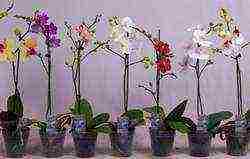
Not a beginner in this business and successfully growing Phalaenopsis orchid? Then you can try to plant a different type of flower - more "complex". For example:
• Dendrobium Orchid. For the active growth of a beauty, coolness is required. Blooms no more than a month.
• Cattleya's orchid. The plant loves a warm, but not hot climate. Flowers can be up to 20 cm in diameter.
• Orchid Wanda. It is a thermophilic species with a powerful root system. The flowers are large, becoming brighter as they develop.
• Orchid Zygopetalum. A plant with beautiful fragrant inflorescences. Petals are two- or three-colored. Representatives of this species do not like the scorching rays of the sun.
Growing an orchid at home is much easier by rooting a cutting. The seeds of the plant are so small that they look like light dust. Seed propagation of an orchid is a complex technology that requires special skills and experience. This growing method is suitable for breeding new hybrids and cultivation in greenhouse conditions. That's why, we will give preference to high-quality cuttingspurchased from local florists and specialized nurseries.
Soil preparation and containers for growing orchids
The main task of the container for planting orchids and the soil mixture used is to support the flower in an upright position, provide oxygen to the roots and remove moisture from them. If there is a wet substrate in the container, the roots of the plant will die.
There must be a lot of voids in the soil, which the garden soil cannot provide - it is too dense. Therefore, the substrate for growing orchids either does not contain land at all, or contains little of it. Novice growers are advised to buy a ready-made mixture for rooting cuttings in the store. Do you want to do it yourself? Then stock up on time and patience. There is several options for preparing the substrate for growing orchids:
• Pine bark (for small flowers - fraction 3-6 mm; for large flowers - bark fraction 6-10 mm).
• Fern + peat + leafy soil + pine bark + charcoal (3: 3: 2: 1: 1).
• Pine bark + coal (10: 1).
Before preparing the soil, the pine bark is dried, otherwise, mold quickly forms in the substrate. Additionally, moss is used, but it is not added to the mixture itself, but the upper roots are covered with it.
As containers for growing orchids, plastic pots, nets, wire pots are suitable. Experienced growers use special purchased blocks, which can consist of bark, cork and driftwood.
Planting an orchid: blocks, pots, baskets
When the container and substrate are prepared, a high-quality stalk is purchased, we proceed to planting the orchid. The key to success is high-quality planting material. The stalk should be free of signs of disease, not shriveled. Sterilize the sections with fungicides, garden varnish, or charcoal before planting.
Planting rules, taking into account the selected capacity:
• Pot. Fill the container 1/3 with drainage (broken shards or bricks, expanded clay, polystyrene). Place an orchid on the drain, the roots of which need to be fixed to the wire base with nylon thread or soft wire. Cover the plant with the prepared substrate so that the horizontal part of the stem remains on the surface of the soil.
• Basket. In this case, a drainage layer is not needed - oxygen will flow unhindered to the roots. Attach a wire mesh to the bottom of the container (often replaced with a layer of bark or moss). Place the roots of the cutting on the grid. Pour the substrate on top. To increase the moisture content of the soil, the cracks in the basket can be closed with moss.
• Block. There should be a hook at the top of the unit to attach it to the wall. If this is not provided for in the purchased material, make a fastener yourself. When growing an orchid in normal humidity conditions, a moss substrate is required under the cutting. Attach the plant to the block (carefully, do not break the roots!), Cover them with moss on top. Fix the orchid on the block using fishing line, wire or nylon thread.
Do not water the planted orchid for several days. Further, the cultivation of a flower will consist in proper care for it - watering, creating good lighting and ventilation, maintaining a normal level of humidity.
We create suitable conditions for growing orchids
Be careful about creating suitable conditions for your orchid, otherwise the plant will not take root. Conditions for growing and caring for a flower:
• Lighting. Indoor orchids need partial shade. If the pot with the plant is on the windowsill, remove it from there closer to noon. The orchid also takes root well under artificial lighting - lamps that give white light are used. When blooming in the fall, provide additional lighting so that the buds do not dry out and have time to bloom. In winter, the flower should be illuminated for at least 12 hours.
• Temperature. The flower tolerates higher temperatures better than cold. The optimal temperature range for growing an orchid is 28-30 ˚С.To stimulate flowering, it can be kept at 12-15 ° C for a couple of weeks.
• Humidity. The optimum humidity level for orchid care is 60-80%. At lower rates, provide for your beauty a special tray with a grate, at the bottom of which water is poured, and a drainage layer is poured on top. Place a tray under the plant so that the evaporating moisture feeds the plant.
• Ventilation. Constant air movement is especially important for cold-loving orchids. But plants will not tolerate drafts! If the room does not have good natural ventilation, you can sometimes turn on the fan.
• Watering. Under normal conditions, an orchid can do without watering for 2 weeks. Water the plant when the substrate is dry. Orchids love abundant watering. The quality of moisture can be judged by the appearance of the root system. If the roots turn green, there is enough moisture in the soil. But their brown color indicates excessive waterlogging. Water the orchid with settled tap water (22-24 ˚С). Try not to let water get on the leaves - you can infect it with rot. Although occasionally (especially in hot weather) you can spray orchid leaves from a spray bottle. During the period when you place the orchid in a cool room to stimulate flowering, watering should be reduced.
• Fertilizer. Feed the plantings with liquid fertilizers designed specifically for orchids every 3-4 weeks. Top dressing can be done by yourself. The plant responds well to the introduction of nitrogenous fertilizers during the growing season.
With good growing conditions and regular feeding, the orchid will bloom and grow vigorously. Gradually, the root system of the flower grows strongly, displacing the substrate from the pot. Has come transplant time beauty in another container. This is done like this:
• Remove the plant from the soil.
• Carefully free the roots from the remaining substrate. If they cannot be cleared of small stones, place the root system in water with warm water for about 20-30 minutes - the adhering soil will be washed off. Dead roots can be cut off so that they do not inhibit the growth of the orchid in the future.
• Dry the orchid (at least 6 hours).
• Prepare in advance a new pot with a larger diameter than before.
• The planting pattern is the same as when rooting the cuttings.
The main task when transplanting a plant is not to injure the roots. If some roots have been removed, the plant will need special care in the first months after changing its "place of residence" - additional support for the trunk, covering with polyethylene to create a greenhouse effect.

What pests and diseases should an orchid be protected from?
Together with the purchased seedling, you can bring uninvited “guests” into the house - pests that can eventually destroy the orchid. We list the most dangerous insects for a flower:
• Shield. A small insect that feeds on plant sap. In the process of its vital activity, mucus is formed, which destroys the living tissues of the orchid. A sign of leaf damage with a scab is dark spots on the leaves. It is not easy to cure the plant - remove all pests from the orchid, spray with a special agent, change the substrate, rinse the leaves with water every five days for a month.

scale insect on orchid
• Scratch. When affected by small "fluffy" insects, orchids begin to turn yellow and fall off the leaves. To detect the worm, regular inspection of the plant is necessary. It is easier to prevent its spread - remove dried leaves in time, regularly wipe the leaves with water. Found pests on an orchid? We'll have to remove each of them with a stick, treat the plant with a special compound.

bug on orchid
• Whitefly. The larvae of this butterfly suck the juice from the orchid, which can lead to the death of the plant. The whitefly is clearly visible - you will immediately see it on the flower.If a pest is found, wash the flower with a solution of laundry soap (1: 6), treat the substrate and plant with a special agent, regularly wipe the leaves with water.
Orchids, even if they live indoors, can also be affected by diseases.
the following "infections" are characteristic:
• Anthracnose. Brown spots appear on the leaves of the orchid, darkening over time. The cause of the lesion is high humidity, abundant moisture of the substrate. To cure the plant, it is necessary to cut out the affected areas, and treat the cut site with wood ash. If large areas are affected, treat the plant with special biological agents.

anthracosis on an orchid
• Powdery mildew. The plant becomes covered with a whitish bloom, which leads to the drying out of the affected area of the plant. The cause of the disease is excessive humidity, high temperature. For treatment, you can spray the orchid with a solution of colloidal sulfur. Water the substrate well a couple of hours before the procedure.
Pests and diseases are not always the reason for the wilting of an orchid - the flower growers themselves, due to a lack of experience in breeding these whimsical flowers, make mistakes.
If you care for your orchid properly, it will delight you for many years.
General rules for caring for an orchid
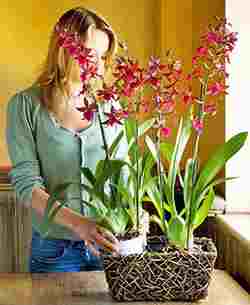 The exotic beauty and sophistication of orchids amazes people even far from floriculture. Is it difficult to tame a tropical beauty, and how to care for an orchid so that it delights with both luscious greenery and luxurious inflorescences?
The exotic beauty and sophistication of orchids amazes people even far from floriculture. Is it difficult to tame a tropical beauty, and how to care for an orchid so that it delights with both luscious greenery and luxurious inflorescences?
Many indoor florists who have not previously grown these unusual plants may get the wrong idea about caring for an orchid as overly painstaking and time-consuming. But getting to know the flowers better, it turns out that keeping an orchid of one of the common types in the room is not so difficult.
How to care for an orchid at home, what conditions are required for an exotic culture that has fallen into a room pot?
Orchid keeping conditions
Properly organized care implies the creation of conditions close to natural. An orchid will preserve health and decorativeness for a long time if:
- all the flower's needs for food, lighting and watering are taken into account and provided;
- the plant is satisfied with the temperature and humidity conditions, the composition of the soil and the applied top dressing.
When choosing a flower for home growing, you need to remember that orchids have many varieties that differ in appearance, conditions of natural growth, and needs.
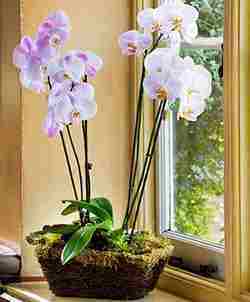 Without disregarding this fact, it is possible to significantly simplify the care of orchids for beginners and for those who already know a lot about the maintenance of this culture of flower growers.
Without disregarding this fact, it is possible to significantly simplify the care of orchids for beginners and for those who already know a lot about the maintenance of this culture of flower growers.
Most of the plants found in interiors are epiphytes that came from the tropics. They are easy to recognize by their juicy airy rhizomes, which not only provide the flower with moisture and nutrition, but also take part in the process of photosynthesis. There are orchids that are used to living on rocks, where the soil layer, like on trees, is extremely small.
For such plants, air humidity and looseness of the substrate are important. But soil species, in addition to the usual care of the orchid, also need nutrient soil.
Lighting features
In the tropics, where the vast majority of indoor species come from, orchids grow in conditions of long daylight hours and moderately bright, diffused lighting. The same conditions are recreated in a situation when the orchid is looked after at home.
The optimal duration of daylight hours for actively growing and flowering orchids is 13-15 hours, practically not decreasing in winter. Therefore, additional lighting will not be superfluous when caring for an orchid.
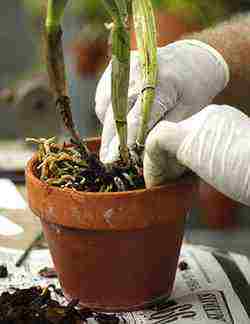 You should not put pots on the southern windows without pre-thought out shading. Bright sunlight can leave brown or yellow marks on the foliage, and the buds will completely fall off under direct hot rays. The best location is the east or west side.On the northern windows, illumination will be required even in the summer.
You should not put pots on the southern windows without pre-thought out shading. Bright sunlight can leave brown or yellow marks on the foliage, and the buds will completely fall off under direct hot rays. The best location is the east or west side.On the northern windows, illumination will be required even in the summer.
If the place for the plant is chosen incorrectly, even with proper home care, orchids, as in the photo, turn yellow, their leaves lose their elasticity, dry, flowering becomes rare or does not occur at all.
Moisture in the air: the key to successful home orchid care
High humidity is extremely important for the successful cultivation of a tropical plant. And if in the summer it is quite possible to reach the desired 60-70%, then in the winter the grower will have to try.
How to properly care for an orchid with heating devices running, mercilessly drying the air in the room? To maintain such air humidity, electric humidifiers and household products are used.
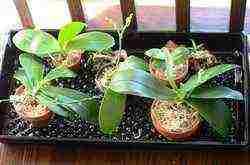 The container in which the flowers are grown can be placed on the moist moss placed in a shallow pan. If there is no sphagnum at hand that retains moisture for a long time, expanded clay is used in the same way. Plants feel best in a florarium or a room greenhouse, separated from the rest of the room by plastic or glass.
The container in which the flowers are grown can be placed on the moist moss placed in a shallow pan. If there is no sphagnum at hand that retains moisture for a long time, expanded clay is used in the same way. Plants feel best in a florarium or a room greenhouse, separated from the rest of the room by plastic or glass.
When a florist in care uses foliar spraying, this should be done regularly and carefully, trying not to get on the flowers. It is highly undesirable to allow the orchid to cool down while it is still wet, as this will lead to the development of fungus on succulent leaves and aerial roots.
 It is necessary to irrigate the flower in the morning with water at room temperature, until the foliage has dried out, the pot is protected in every possible way from cold air and drafts.
It is necessary to irrigate the flower in the morning with water at room temperature, until the foliage has dried out, the pot is protected in every possible way from cold air and drafts.
Watering when caring for an orchid in a pot
Studying information on how to care for an orchid at home, a novice florist should not ignore such a question as watering these natives of the tropics.
The appearance of a plant alone can tell a lot about its preferences and needs. Powerful aerial and underground rhizomes are designed to extract and store moisture. In addition, the flower can save some amount of nutrients and water in the leaves, which are noticeably thickened in some species.
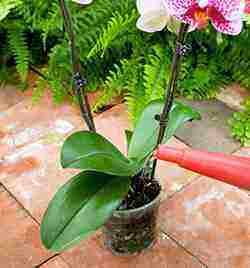 All orchids are moisture-loving and require abundant watering, in which the soil clod or loose coarse-grained substrate poured into a pot is completely wet.
All orchids are moisture-loving and require abundant watering, in which the soil clod or loose coarse-grained substrate poured into a pot is completely wet.
But how to care for an orchid at different times of the year? Does the frequency of watering change, and how do you know about the "thirst" of a flower in a mixture of bark, expanded clay, pieces of foam plastic and other materials that have little resemblance to traditional soil?
The watering schedule, like other orchid care procedures, must be adjusted when the season changes. In the warmer months, the potted orchid receives water more often than in winter. But it is better to underfill the plant than to fill it.
Thick leaves and roots will help the orchid survive a short-term drought, but excess moisture, and especially its stagnation, is a sure step towards root decay.
 Tropical guests at home are planted in transparent plastic pots or containers with special slots. This makes it possible to monitor the state of the root system, the rhizomes themselves participate in photosynthesis and more easily consume nutrients and moisture. But how to care for an orchid in a pot of such an unusual design?
Tropical guests at home are planted in transparent plastic pots or containers with special slots. This makes it possible to monitor the state of the root system, the rhizomes themselves participate in photosynthesis and more easily consume nutrients and moisture. But how to care for an orchid in a pot of such an unusual design?
There are no peculiarities of caring for an orchid here, except that you have to water the flower in a solid container from above, and it is convenient to immerse the pots with slots in prepared water for 4-6 minutes. During this time, the substrate will be saturated with moisture, and the excess will drain freely.
In summer, the substrate is moistened 2-3 times a week, when the surface of the soil is dry to the touch. In the cold season, the frequency of watering is sharply reduced.
The need for water is recognized by the rhizomes that have lost their elasticity, slightly wrinkled and drooping leaves. A healthy plant quickly recovers after moistening the soil.
But the sluggish foliage of regularly watered orchids should alert the grower.Perhaps the roots were once flooded and are now in need of reorganization.
Feeding indoor orchids
Like other indoor crops forced to grow in a limited amount of substrate, orchids need regular feeding. But you shouldn't fertilize these plants too often. It is optimal if specialized liquid formulations are applied no more than twice a month and only during the period of active growth and flowering.
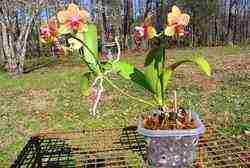 The increased salt content in the soil negatively affects the condition of the plant. How to care for an orchid if traces of salinity appear on the surface of the filler in the pot? It is better not to fight this phenomenon, but to prevent its occurrence. Therefore, feeding is alternated with rinsing the root system, for which the pot is immersed in warm soft water for several minutes.
The increased salt content in the soil negatively affects the condition of the plant. How to care for an orchid if traces of salinity appear on the surface of the filler in the pot? It is better not to fight this phenomenon, but to prevent its occurrence. Therefore, feeding is alternated with rinsing the root system, for which the pot is immersed in warm soft water for several minutes.
If the fertilizing included in the care of the orchid is excessive, the flower tolerates temperature changes worse, and is also more often affected by pests and fungi.
Orchid care after flowering
 The wilting of flowers on an orchid is a sure sign that the plant is preparing for a dormant period. It will not lose foliage, but there will be much less development and nutrition until the future appearance of buds. How to care for an orchid at this time?
The wilting of flowers on an orchid is a sure sign that the plant is preparing for a dormant period. It will not lose foliage, but there will be much less development and nutrition until the future appearance of buds. How to care for an orchid at this time?
First of all, it is worth paying attention to the peduncle left without bright corollas. As long as it retains its green color and juiciness, it is left.
In some cases, on the same peduncle, the buds are re-formed, and daughter plants, tiny rosettes are also formed, which, when their own roots are formed, are cut and planted in a separate pot, in a loose substrate for orchids. But signs of wilting of the peduncle suggest that it is time to cut it out.
If the indoor orchid has bloomed for a long time and abundantly, it is not correct to allow the re-emergence of buds, as is the case with certain plant varieties. This will only further weaken the flower.
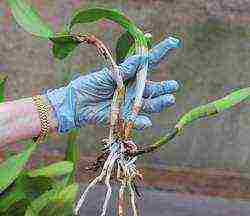 In order for the culture to quickly and well restore its strength, after flowering, the care of the orchid includes feeding or transplanting a flower. However, the latter procedure can be stressful for the plant, since the roots not only tightly wrap around the substrate, but also penetrate the holes and go outside the pot.
In order for the culture to quickly and well restore its strength, after flowering, the care of the orchid includes feeding or transplanting a flower. However, the latter procedure can be stressful for the plant, since the roots not only tightly wrap around the substrate, but also penetrate the holes and go outside the pot.
A video about caring for an orchid at home will explain all the intricacies of handling a spectacular tropical flower. Subject to the rules that are simple, even for a beginner, the indoor collection will be replenished with an amazingly beautiful plant, which, feeling cared for, will respond with a long bright flowering.
Proper care of an orchid - video
The basics of growing an orchid at home
What type to choose for the house
You can grow a variety of orchids at home. However, it is important to choose the right variety so that you do not have problems with flower care in the future. After all, each type of plant has its own set of requirements for growing conditions. If everything is organized correctly, then caring for orchids in a flowerpot will be simple.
For growing orchids at home, the following varieties are suitable:
- Phalaenopsis. It is Phalaenopsis that is grown more often at home than other types of plants. This flower is distinguished by long flowering, and its flowers can have a wide variety of colors. Growing any phalaenopsis at home will be within the power of even a beginner;
- Dendrobium. Orchids of this species grow in the cool. The flowering period is more than one month;
- Cattleya. Growing conditions for this variety require a warm, but not hot, microclimate. The formation of rather large flowers is characteristic;
- Wanda. It is a heat-loving plant that has a powerful root system. As they develop, the flowers become brighter;
- Zygopetalum. This variety is characterized by the formation of fragrant inflorescences.
There should be no problems with the orchids listed above at home. However, in order to get them to bloom for a long time, you need to know the types of orchids and the secrets of growing each individual variety.
Soil and capacity
To understand how to grow your favorite orchid in a house or apartment, you need to know the specifics of choosing a container and soil for planting a flower.
Growing plants is carried out in a pot, which must meet the following requirements:
- able to support the flower in an upright position;
- provides oxygen and moisture to the roots;
- promotes effective drying of the substrate.
Plastic pots, wire pots and nets have the right characteristics. The Phalaenopsis orchid and its other varieties are most often planted in pots with transparent walls so that the roots can participate in the process of photosynthesis.
In order to grow orchids at home, you need to choose the right substrate. These indoor flowers are planted on a special substrate in which there is no earth at all. It may include the following components:
The ratio of the components of the substrate is determined depending on which plant species is planned to be grown in houses or apartments. The substrate can be prepared by hand. But many growers go to specialized stores to buy soil. In the same place, the seller will tell you how to grow 100 or more specimens from one orchid, having bought only one flower. To do this, you just need to know how a particular orchid is grown.
Comfortable conditions
Caring for Phalaenopsis at home involves observing certain parameters of temperature, humidity and illumination. Let's consider in more detail what kind of care and what parameters should be observed when growing these flowers. The secrets of growing orchids will be available to you too.
Lighting and temperature
Phalaenopsis loves partial shade. When placing a flowerpot on a windowsill, avoid direct sunlight. Artificial lighting for orchids is allowed. To do this, you can use special phytolamps, which are designed for additional illumination of indoor plants. This indoor orchid lamp is sold in specialized stores.
Additional illumination should give white light. It is this kind of light that is needed in order for the indoor species to grow and bloom. The backlight is often used in winter, when the daylight hours are the shortest. In the cold season, flowers should be illuminated for at least 12 hours. For this, a phytolamp for indoor orchids is placed above the pot.
In addition to the light regime, a certain temperature is needed for orchids. These indoor plants are better tolerated at elevated temperatures. The optimum temperature for keeping colors is in the range of + 28-30 degrees.
For any gardener who has grown Phalaenopsis at home, it will be useful to know that to stimulate flowering, the plant must be at a temperature of + 12-15 degrees for several weeks.
An important point in how to grow orchids in an apartment is compliance with the water regime. Watering the flower is carried out only when the substrate dries up. Regarding how to correctly determine the degree of dryness of the substrate, there are several ways (poke into the ground with your finger or stick, etc.). You need to water the plant only with settled warm water.
These plants should grow in a humidity range of 60–80%. In order to achieve this level, the plant is periodically sprayed with water and also ventilated. Ventilation is important for cold-hardy species.
How to care for a specific species, you can find out from the seller, who will tell you all the wisdom of its breeding. Experienced growers can also give advice on breeding.
Pests and diseases
For many flower lovers who grew in the conditions of the Phalaenopsis apartment, flowers were often invaded by parasites or pathogens. Such a situation is possible if planting and care were improperly organized for them (plants).
Plants most often suffer from the following parasites:
- shield. When it appears on the plant, mucus and dark spots are formed;
- worm. When infected, the leaves turn yellow, which then fall off;
- whitefly. The insect feeds on plant sap. As a result, the flower may die.
These indoor flowers most often affect the following ailments:
- anthracnose. The appearance of brown spots is characteristic;
- powdery mildew. A white bloom forms on the flower.
How to grow Phalaenopsis without diseases and pests? You just need to properly organize the care for the plant. This is easy to do, because you only need to create the correct water and temperature conditions, as well as lighting.
Transplant secrets
An orchid in its cultivation includes a mandatory transplant, which is carried out every two years. More frequent transplants are carried out only when necessary (for example, a large number of parasites in a pot).
The transplant should be done in the spring or summer. This procedure consists of the following steps:
- the plant is well watered in a day;
- then the flower is taken out of the pot and placed in water to soak off the roots of the substrate;
- further all rotten roots are removed;
- the plant is placed in a selected pot and covered with new soil;
- watering is carried out after 1-2 days.
The secret of a successful flower transplant lies in the fulfillment of these points.
Now you know the secrets of growing and caring for indoor orchids.
Video "Growing an orchid at home"
This video will show you how to grow a blooming orchid at home.
The use of materials is allowed only with an active link to the source!
Read also
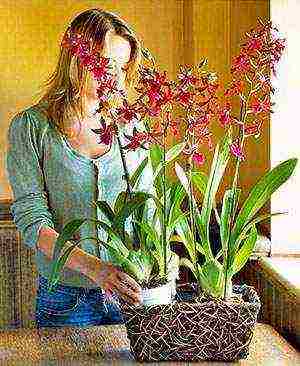 The exotic beauty and sophistication of orchids amazes people even far from floriculture. Is it difficult to tame a tropical beauty, and how to care for an orchid so that it delights with both luscious greenery and luxurious inflorescences?
The exotic beauty and sophistication of orchids amazes people even far from floriculture. Is it difficult to tame a tropical beauty, and how to care for an orchid so that it delights with both luscious greenery and luxurious inflorescences?
Many indoor florists who have not previously grown these unusual plants may get the wrong idea about caring for an orchid as overly painstaking and time-consuming. But getting to know the flowers better, it turns out that keeping an orchid of one of the common species in the room is not so difficult.
How to care for an orchid at home, what conditions are required for an exotic culture that has fallen into a room pot?
Orchid keeping conditions
Properly organized care implies the creation of conditions close to natural. An orchid will preserve health and decorativeness for a long time if:
- all the flower's needs for food, lighting and watering are taken into account and provided;
- the plant is satisfied with the temperature and humidity conditions, the composition of the soil and the applied top dressing.
When choosing a flower for home growing, you need to remember that orchids have many varieties that differ in appearance, conditions of natural growth, and needs.
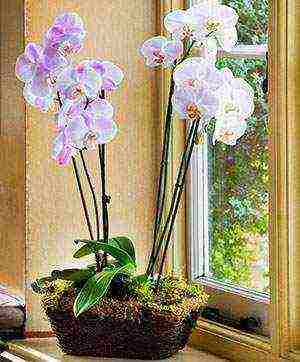 Without disregarding this fact, you can significantly simplify the care of orchids for beginners and for those who already know a lot about the maintenance of this culture of flower growers.
Without disregarding this fact, you can significantly simplify the care of orchids for beginners and for those who already know a lot about the maintenance of this culture of flower growers.
Most of the plants found in interiors are epiphytes that came from the tropics. They are easy to recognize by their juicy airy rhizomes, which not only provide the flower with moisture and nutrition, but also take part in the process of photosynthesis. There are orchids that are used to living on rocks, where the soil layer, like on trees, is extremely small.
For such plants, air humidity and looseness of the substrate are important. But soil species, in addition to the usual care of the orchid, also need nutrient soil.
Lighting features
See also: how to properly care for the Phalaenopsis orchid
In the tropics, where the vast majority of indoor species come from, orchids grow in conditions of long daylight hours and moderately bright, diffused lighting. The same conditions are recreated in a situation when the orchid is looked after at home.
The optimal duration of daylight hours for actively growing and flowering orchids is 13-15 hours, practically not decreasing in winter. Therefore, additional lighting will not be superfluous when caring for an orchid.
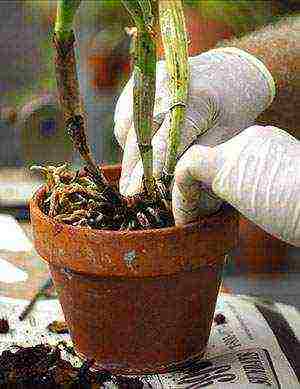 You should not put pots on the southern windows without pre-thought out shading. Bright sunlight can leave brown or yellow marks on the foliage, and the buds will completely fall off under direct hot rays. The best location is the east or west side. On the northern windows, illumination will be required even in the summer.
You should not put pots on the southern windows without pre-thought out shading. Bright sunlight can leave brown or yellow marks on the foliage, and the buds will completely fall off under direct hot rays. The best location is the east or west side. On the northern windows, illumination will be required even in the summer.
If the place for the plant is chosen incorrectly, even with proper home care, orchids, as in the photo, turn yellow, their leaves lose their elasticity, dry, flowering becomes rare or does not occur at all.
Moisture in the air: the key to the success of orchid care at home
High humidity is extremely important for the successful cultivation of a tropical plant. And if in the summer it is quite possible to reach the desired 60-70%, then in the winter the grower will have to try.
How to properly care for an orchid with heating devices running, mercilessly drying the air in the room? To maintain such air humidity, electric humidifiers and household products are used.
 The container in which the flowers are grown can be placed on the moist moss placed in a shallow pan. If there is no sphagnum at hand that retains moisture for a long time, expanded clay is used in the same way. Plants feel best in a florarium or a room greenhouse, separated from the rest of the room by plastic or glass.
The container in which the flowers are grown can be placed on the moist moss placed in a shallow pan. If there is no sphagnum at hand that retains moisture for a long time, expanded clay is used in the same way. Plants feel best in a florarium or a room greenhouse, separated from the rest of the room by plastic or glass.
When a florist in care uses foliar spraying, this should be done regularly and carefully, trying not to get on the flowers. It is highly undesirable to allow the orchid to cool while still wet, as this will lead to the development of fungus on succulent leaves and aerial roots.
 It is necessary to irrigate the flower in the morning with water at room temperature, until the foliage has dried out, the pot is protected in every possible way from cold air and drafts.
It is necessary to irrigate the flower in the morning with water at room temperature, until the foliage has dried out, the pot is protected in every possible way from cold air and drafts.
Watering when caring for an orchid in a pot
Studying information on how to care for an orchid at home, a novice florist should not ignore such a question as watering these natives of the tropics.
The appearance of a plant alone can tell a lot about its preferences and needs. Powerful aerial and underground rhizomes are designed to extract and store moisture. In addition, the flower can save some amount of nutrients and water in the leaves, which are noticeably thickened in some species.
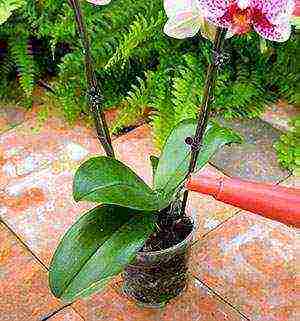 All orchids are moisture-loving and require abundant watering, in which the soil clod or loose coarse-grained substrate poured into a pot is completely wet.
All orchids are moisture-loving and require abundant watering, in which the soil clod or loose coarse-grained substrate poured into a pot is completely wet.
But how to care for an orchid at different times of the year? Does the frequency of watering change, and how do you know about the "thirst" of a flower in a mixture of bark, expanded clay, pieces of foam plastic and other materials that have little resemblance to traditional soil?
The watering schedule, like other orchid care procedures, must be adjusted when the season changes. During the warmer months, the potted orchid receives water more often than in the winter. But it is better to underfill the plant than to fill it.
Thick leaves and roots will help the orchid survive a short-term drought, but excess moisture, and especially its stagnation, is a sure step towards root decay.
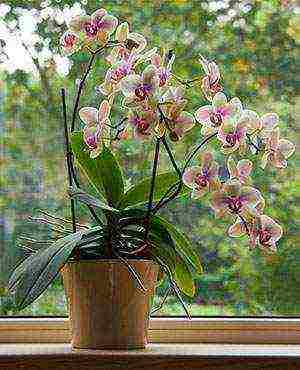 Tropical guests at home are planted in transparent plastic pots or containers with special slots. This makes it possible to monitor the state of the root system, the rhizomes themselves participate in photosynthesis and more easily consume nutrients and moisture. But how to care for an orchid in a pot of such an unusual design?
Tropical guests at home are planted in transparent plastic pots or containers with special slots. This makes it possible to monitor the state of the root system, the rhizomes themselves participate in photosynthesis and more easily consume nutrients and moisture. But how to care for an orchid in a pot of such an unusual design?
There are no peculiarities of caring for an orchid here, except that you have to water the flower in a solid container from above, and it is convenient to immerse the pots with slots in prepared water for 4-6 minutes. During this time, the substrate will be saturated with moisture, and the excess will drain freely.
In summer, the substrate is moistened 2-3 times a week, when the surface of the soil is dry to the touch. In the cold season, the frequency of watering is sharply reduced.
The need for water is recognized by the rhizomes that have lost their elasticity, slightly wrinkled and drooping leaves. A healthy plant quickly recovers after moistening the soil.
But the sluggish foliage of regularly watered orchids should alert the grower. Perhaps the roots were once flooded and are now in need of reorganization.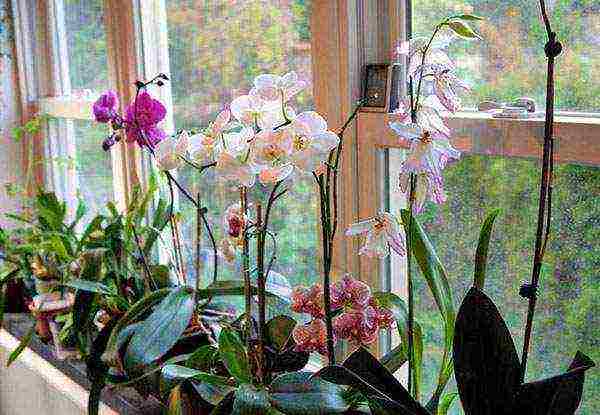
Feeding indoor orchids
Like other indoor crops forced to grow in a limited amount of substrate, orchids need regular feeding. But you shouldn't fertilize these plants too often. It is optimal if specialized liquid formulations are applied no more than twice a month and only during the period of active growth and flowering.
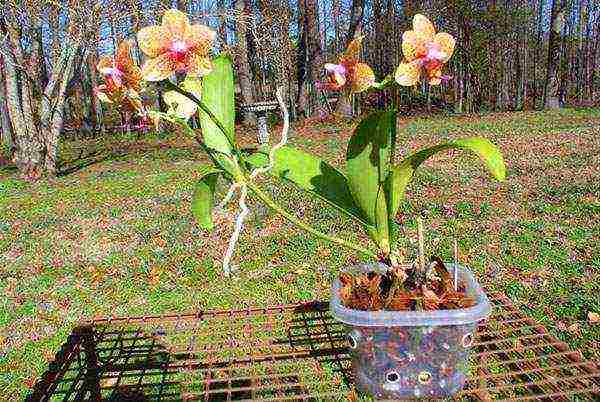 The increased salt content in the soil negatively affects the condition of the plant. How to care for an orchid if traces of salinity appear on the surface of the filler in the pot? It is better not to fight this phenomenon, but to prevent its occurrence. Therefore, feeding is alternated with rinsing the root system, for which the pot is immersed in warm soft water for several minutes.
The increased salt content in the soil negatively affects the condition of the plant. How to care for an orchid if traces of salinity appear on the surface of the filler in the pot? It is better not to fight this phenomenon, but to prevent its occurrence. Therefore, feeding is alternated with rinsing the root system, for which the pot is immersed in warm soft water for several minutes.
If the fertilizing included in the care of the orchid is excessive, the flower tolerates temperature changes worse, and is also more often affected by pests and fungi.
Orchid care after flowering
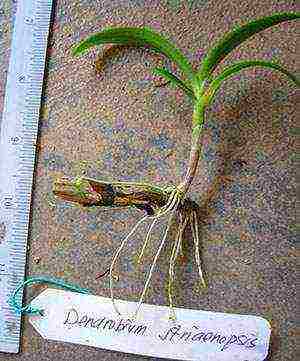 The wilting of flowers on an orchid is a sure sign that the plant is preparing for a dormant period. It will not lose foliage, but there will be much less development and nutrition until the future appearance of buds. How to care for an orchid at this time?
The wilting of flowers on an orchid is a sure sign that the plant is preparing for a dormant period. It will not lose foliage, but there will be much less development and nutrition until the future appearance of buds. How to care for an orchid at this time?
First of all, it is worth paying attention to the peduncle left without bright corollas. As long as it retains its green color and juiciness, it is left.
In some cases, on the same peduncle, the buds are re-formed, and daughter plants, tiny rosettes are also formed, which, when their own roots are formed, are cut and planted in a separate pot, in a loose substrate for orchids. But signs of wilting of the peduncle suggest that it is time to cut it out.
If the indoor orchid has bloomed for a long time and abundantly, it is not correct to allow the re-emergence of buds, as is the case with certain plant varieties. This will only further weaken the flower.
 In order for the culture to quickly and well restore its strength, after flowering, the care of the orchid includes feeding or transplanting a flower. However, the latter procedure can be stressful for the plant, since the roots not only tightly wrap around the substrate, but also penetrate the holes and go outside the pot.
In order for the culture to quickly and well restore its strength, after flowering, the care of the orchid includes feeding or transplanting a flower. However, the latter procedure can be stressful for the plant, since the roots not only tightly wrap around the substrate, but also penetrate the holes and go outside the pot.
A video about caring for an orchid at home will explain all the intricacies of handling a spectacular tropical flower. Subject to the rules that are simple, even for a beginner, the indoor collection will be replenished with an amazingly beautiful plant, which, feeling cared for, will respond with a long bright flowering.
Proper care of an orchid - video


